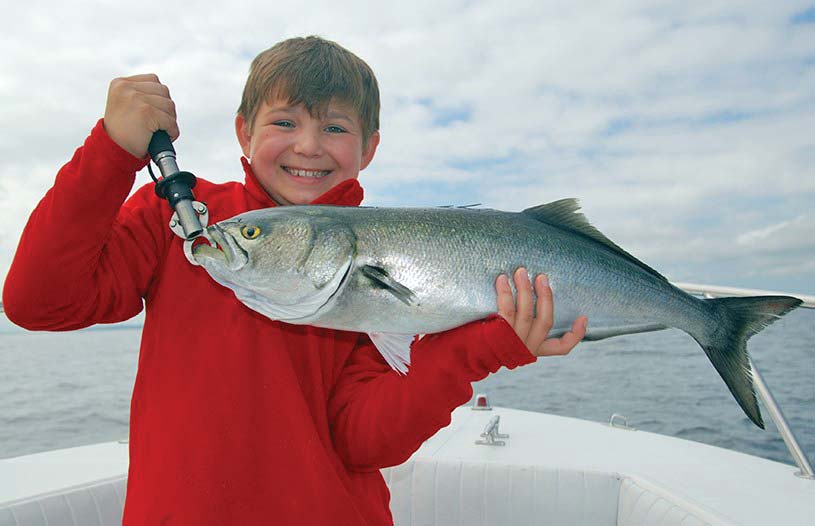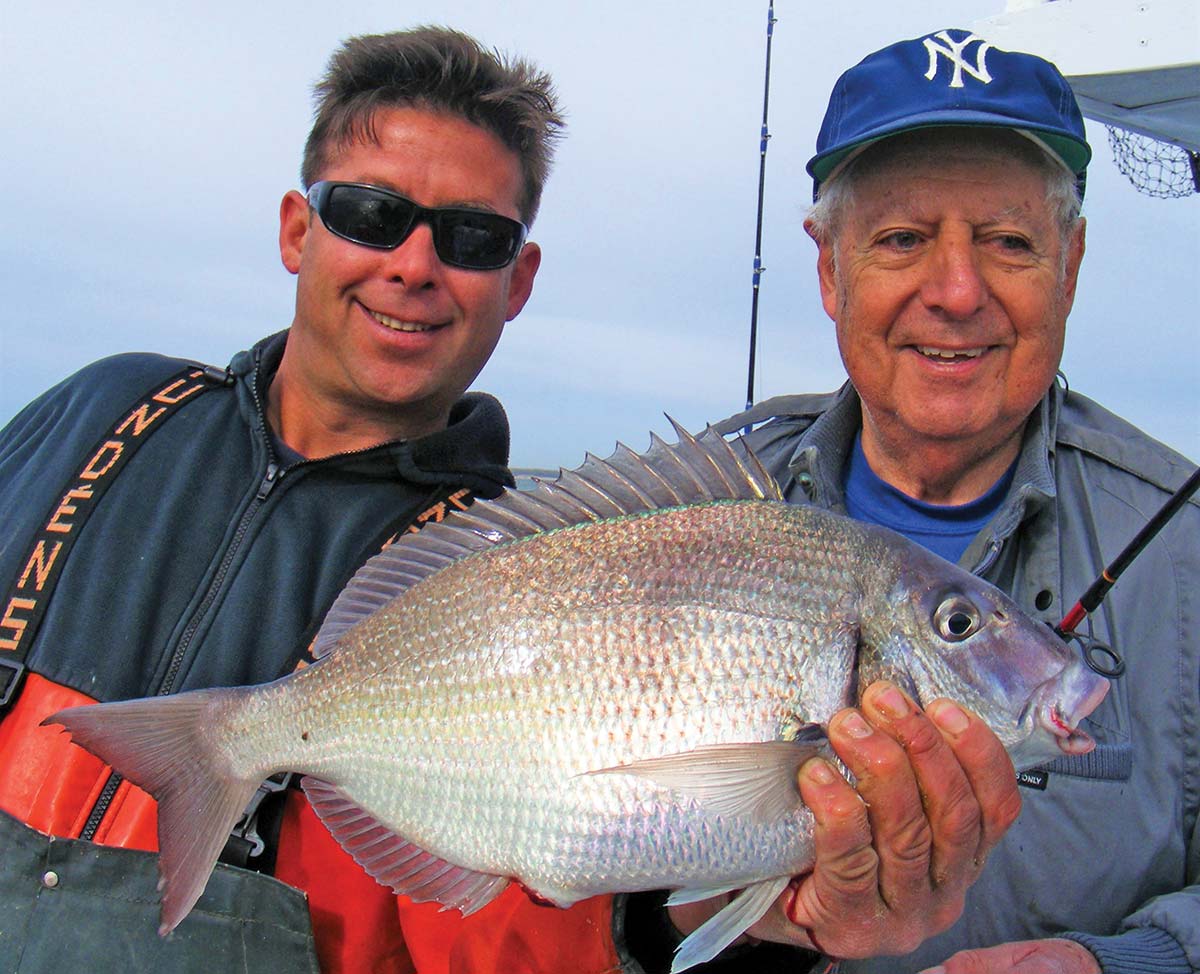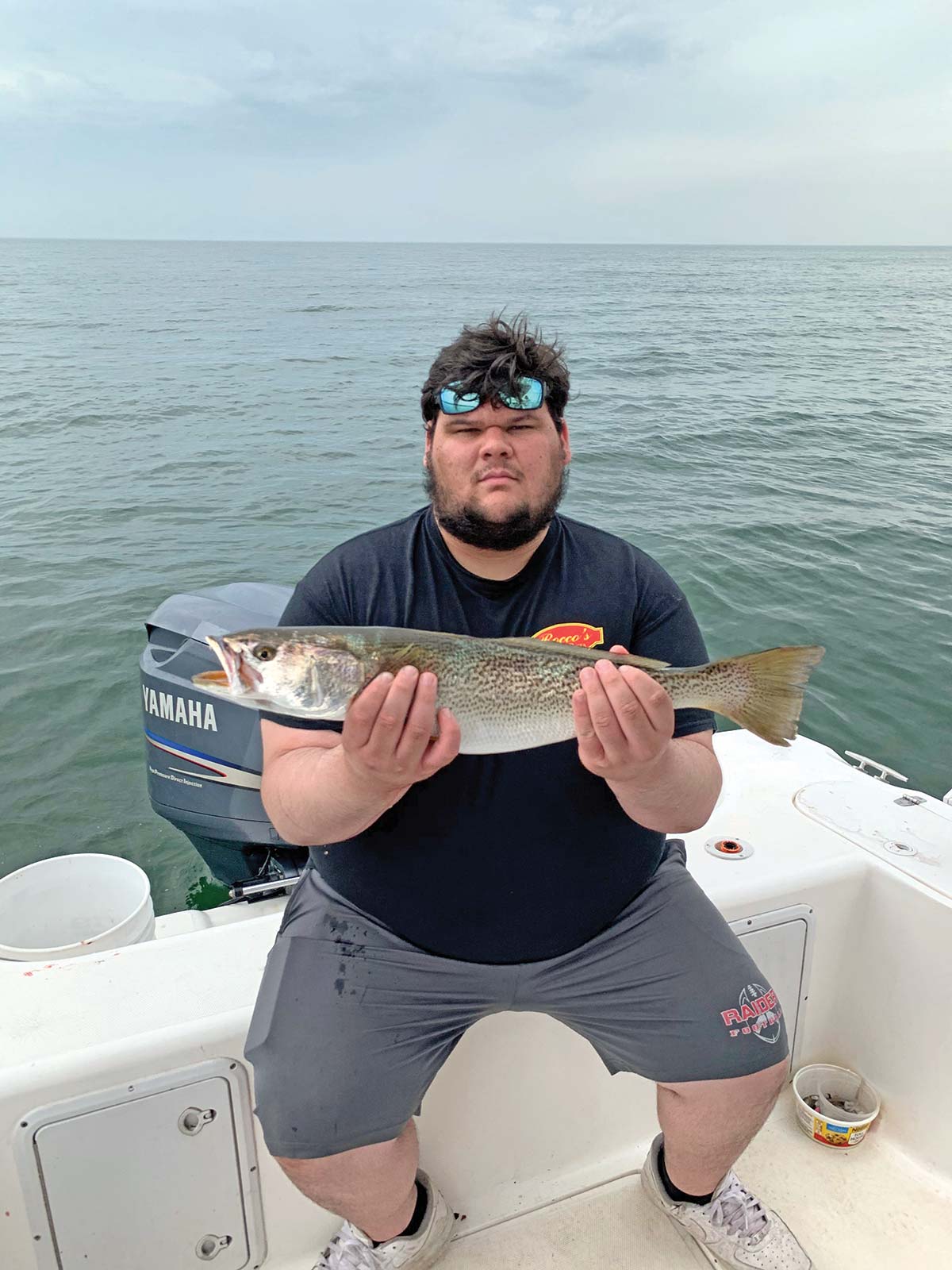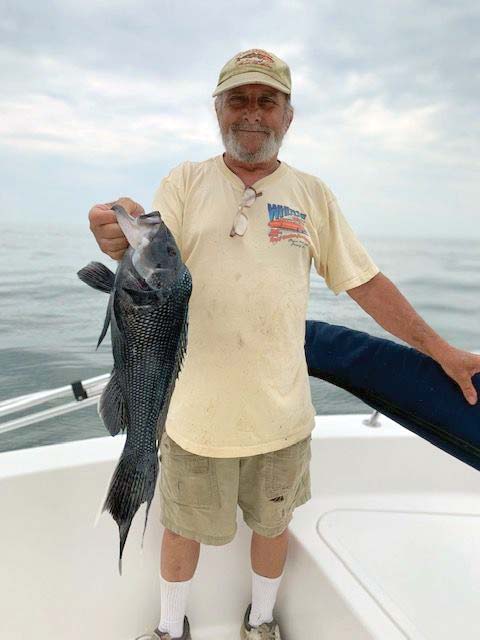
Fish the middle of the Sound to beat the summer doldrums.
It’s usually uncommon to find an area to fish where an assortment of species can be found, especially during mid-summer; however, a piece of the Long Island Sound has just the place. Starting in July and going right into the fall, Stratford Shoal otherwise known as the Middle Grounds a spot where each season anglers from the Central North Shore of Long Island enjoy the chance to roundup porgies, sea bass, weakfish, striped bass, bluefish, chub mackerel and even the occasional Spanish mackerel from this oasis. If this stimulates your taste buds, then apply the Coppertone lotion and get ready for some cool action under a hot sun.
Smack In The Middle
Between the central shorelines of Long Island and Connecticut, the Middle Grounds (41 03 06N / 73 06 01W) is an area approximately three miles in radius, surrounding a high spot officially known as the Stratford Shoal. Located just six miles north of Port Jefferson Harbor, the Stratford Shoal is a rocky reef three quarters of a mile long.
At one time during the 17th century, the 6- to 10-foot shoal was charted as two islands surrounded by deep water. Within one hundred years, the sea eroded the low-lying land to form a three quarter of a mile shoal. To minimize tragic accidents, due to inexperienced navigators, a lighthouse was built on the shoal, which remains an active navigation aid to this day. According to Captain Desmond O’Sullivan of the Port Jefferson based open boat the Celtic Quest, the rock-strewn bottom as well as several sunken wrecks make the Stratford Shoal and its surrounding environment a fish haven for a variety of species throughout the season including good tog fishing during October and November that gets the attention of anglers.

Goodies Along The Bottom
Should porgy and sea bass fishing be your forte, you’ll want to fish along the northeast corner of the Stratford Shoal in 30-feet of water just south of Buoy “1″, and east of Buoy “3″ in 60 feet of water, preferably during the start and the end of an ebb tide when the current isn’t raging. Besides, you’ll want to save the stage of the strong currents for the stripers and blues.
This area holds an abundance of rocks which makes the perfect sanctuary for species such as sea bass and porgies during the summer and early fall, then some solid blackfish action during late October and much of November. I strongly suggest that you slowly motor along this area focusing on your bottom recorder marking and anchoring over areas that rise marginally, or over bottom that is erratic or broken up.
Since this area of the Middle Ground lies in relatively shallow water compared to the rest of the Sound, lightweight sinkers usually prevail during a slacking tide. Bank sinkers to 5 ounces should be sufficient; however, sinkers to 8 ounces are usually required around a new or full moon. Since the bottom can be quite sticky, you may want to beef up the tackle a bit—a 6- or 7-foot stout rod rated to 25 pounds with a fast tapered tip matched to a conventional reel and spooled with no less than 20-pound braid. Standard hi/lo bottom rigs to go with the bank sinkers baited with clams, squid and sandworms will fill the cooler with tasty scup and biscuits.
These days more and more anglers are becoming sporty and conservation-minded by employing metal jigs. Porgies and sea bass are not finicky when it comes to viciously attacking hard metal jigs. Some of the metal tasting imitations include the Tsunami Marathon Diamond Jig. The sleek aqua-dynamic design with durable triple chrome plating leaves a long-lasting bright silver finish and are also available in a holographic finish design. Top quality Mustad hooks round out the jigs and are available between 2 and 8 ounces. If you want some shake, rattle and roll in your arsenal, then you’ll love the Raging Rattler from S&S Bucktails. The Raging Rattler has a full glow head and skirt but also has an internal rattle. Curiosity catches the attention of the sea bass and draws them in. Also off the S&S line is the Octopi and the Flutter Jigs that are must-haves if you take jigging scup and biscuits seriously.
Gamesters In The Hood
Okay we acknowledge that some incredibly favored species take refuge along the rocky bottom of the Middle Grounds, and I hope you have a better understanding of the potential that awaits if you play the stages of the tides correctly. Conversely, the fast and powerful currents that share its duties with the strong current of the eastern end of the Long Island Sound during peak tidal stages makes bottom fishing extremely difficult to keep an average weighted lead sinker or scup/sea bass jigs in constant contact with the bottom. Fret not as the window of opportunity opens up for the gamefish lover in you since stripers, blues, Spanish and chub mackerel and even an occasional cobia may be found feasting in these fast moving waters. The variety of bottom contours creating all sorts of rip lines and drop-offs anywhere from 15 to 65 feet, making it an oasis for bass and bluefish, especially from July and into the fall. Fishing across the rips will produce the bass and blues coming into and drifting off the shoal. Learn the proper techniques and tactics to dupe these gamesters to your hook and you can then really consider the Middle Grounds a real “fishing paradise”.

Snap That Whip
Our legendary late Senior Editor and my incredibly special friend, Mr. Fred Golofaro, was one of the first fishermen that explained “snap jigging” with bucktails to me. The concept is accomplished by using short, sharp rod tip snaps to quickly twitch the bucktail jig, imparting erratic action while keeping the jig at a specific depth in the strike zone. The key to success is to be sure that you feel and always have control of the jig.
The snap jigging technique is rather popular among savvy anglers that work the countless rip lines that can be found around the Middle Grounds, so there is plenty of room for everyone. Having the proper tackle is relevant to successful jigging that often pays dividends in big ways. Therefore moderate tapered spinning outfits are best suited for the task at hand. My favorite outfit is a 7-foot Shimano M Legend matched to a Shimano Stella 3000 filled with 15-pound Spro Saltwater Series Depth Control 8X attached, via an Albright knot, to and 8-foot length of Spro’s 30-pound RT Fluorocarbon leader. Spro’s Power Bucktail completes the set up in the appropriate size.
What I like to do is motor and cast upward of an oncoming rip line, using short, sharp twitches while tending line slack with the reel. Work varying sections of the water column by retrieving vertically or dropping slack to allow the jig to sink. Always pay close attention to slack line while snap jigging. Strikes often occur on the drop back of the bucktail.
Bird Brains Do The Work
One thing is always certain about the Middle Grounds, with the abundance of a myriad of baitfish along much of the water column, you can count on gulls and terns to be constantly overhead wheeling the area in hopes of some easy meals close or along the surface. Typically locating stripers and bluefish is not difficult if a school of the baitfish and gamester’s surfaces and are feeding. The terns and gulls dip down to pick up any scraps or freebies that the prey might trap to the surface. Commonly, locating flocks of excited seagulls that are grubbing free meals from the frenzied feeding stripers is known as a blitz. During a blitz anglers will cast or drop down their jigs of choice as they cautiously approach a school of fish. Often these fish are on the move and are not going to stick around for that Kodak moment before a safe and healthy release. Most times as you snap your friends picture with that slob bass he has dreamed of catching, that same school of bass will have either sounded or have traveled out of reach which means you’ll be doing a lot of running and gunning which can be rather exhausting. However on the days of heavy boat traffic, most species will stay close to the bottom where snap jigging the rip lines will be more effective. If you really prefer surface activity, be on the grounds by sunrise or on cloudy and rainy days when most fair weather people stay in bed rather than having a grand time bailing and releasing fish.
Another issue of concern is too often when anglers come upon a school of surface feeding blues or bass, they make the common mistake to cast across or motor through the center of the surfaced school. Such practice often causes the bass to scatter. For this reason, the habit of chasing surfaced schools will often ruin chances not only for the chaser, but also for all the others in the vicinity. It is far better to drift and cast toward the fish. When casting, the lure should land either just ahead of the line of movement of the school, or on the side of the school nearest to you. As for lures, flies, plugs, jigs will all be effective, therefore go with the things that you like the most as odds are blitzing bass and definitely bluefish will smack anything put in front of them. As for a Spanish mackerel or cobia, for the time being they may be more of a possibility than a given. If the duo are present, rest assured they will smack your offering as well.

Watch The Weather
Although Long Island Sound can be as flat as a lake, it can also become quite lumpy. As most of us all know, a tight chop can make for wet and uncomfortable motoring and drifting. Since this hotspot is a 6- to 7-mile hike from most bays and harbor inlets, getting to and from the inlet can become quite a challenge. Therefore, be sure to check out NOAA weather reports for sea conditions, wind velocity and especially thunderstorms. Keep in mind that winds from both the north and east will produce challenging tight chops, especially against hard moving currents.
This summer beat the doldrums and head for the Middle Grounds for a slew of different options. The area will hold fish for most of the season due to its contour. Cool, deep water nearby is another reason why this spot stays productive through the summer months as well. Don’t forget to take in the historic sight of the actual Stratford Shoal Lighthouse as well while you’re out there. Rumors are it might even be haunted!



